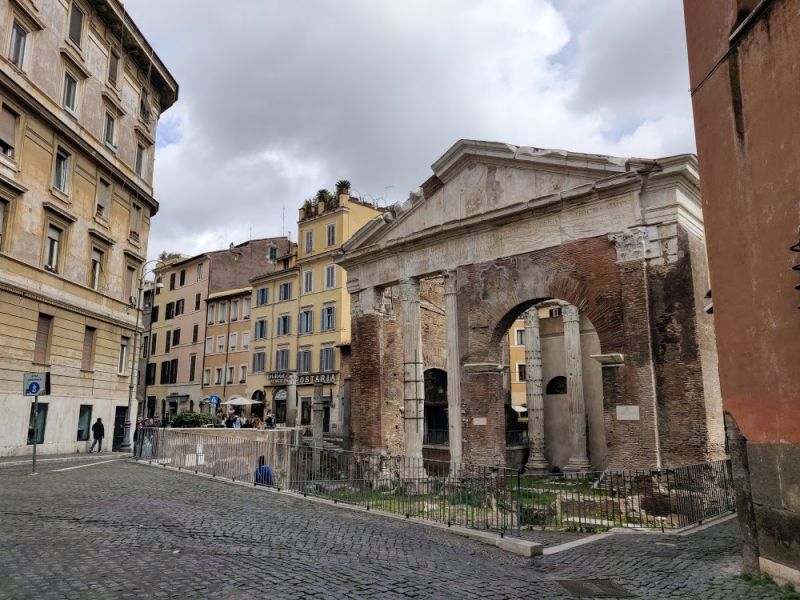
Rome, Italy, Oct 17, 2023 / 12:37 pm (CNA).
Hundreds of people took to the streets of Rome on Monday evening to mark the 80th anniversary of the Nazi roundup and deportation of more than 1,200 Jews from Rome to the Auschwitz-Birkenau concentration camp.
The March of Remembrance commenced at the Piazza del Campidoglio, home to Rome’s city hall, and concluded in front of the ancient Portico d’Ottavia in the heart of the Jewish ghetto. This annual event has been held for the past 30 years and is jointly organized by the Catholic community of Sant’Egidio and the Jewish Community of Rome.
Established in 1555, the Jewish ghetto of Rome is one of the oldest in Europe. It is located in the city center, bordered by the Tiber River and the Trastevere neighborhood on the south and Piazza Venezia on the north.
On Sept. 10, 1943, two days after Italy’s surrender, the German Wehrmacht occupied Rome. The city remained under Nazi control until its liberation by Allied forces a year later, on June 4, 1944.
On Oct. 16, 1943, the Gestapo raided the ghetto, rounding up 1,022 Jews who were subsequently deported to the Auschwitz concentration camp in Poland.
“Two hundred were children. Sixteen of them returned, only one woman among them,” Rome’s chief rabbi, Riccardo Di Segni, told the crowd at the event’s concluding ceremony.
Among the speakers on the stage were the president of Italy, Sergio Mattarella; the mayor of Rome, Roberto Gualtieri; Di Segni; Victor Fadlun, president of the Jewish Community of Rome organization; Andrea Riccardi, founder of the Community of Sant’Egidio; representatives of the Italian Parliament; and members of Prime Minister Giorgia Meloni’s cabinet.
Cardinal Matteo Zuppi, president of the Italian Bishops’ Conference; Bishop Vincenzo Paglia, president of the Pontifical Academy for Life; and Ambrogio Spreafico, bishop of Anagni-Alatri, were also present.
This was an opportunity to remember “one of the most shocking and inhuman events that our city experienced in the 20th century,” Gualtieri said in his remarks.
“It is necessary to always recognize and fight the virus of anti-Semitism when it appears in its multiple metamorphoses,” he continued. “This is also why it is important to be here today.”
The mayor also took a moment to honor two survivors of the Holocaust, Tatiana Bucci and Sami Modiano, 85 and 92 years old, respectively, who were present at the event.
“The novelty of the Shoah [the Holocaust] was that of the systematic and technological organization of the extermination,” Di Segni told the crowd assembled in front of the Portico d’Ottavia. “But the massacres of the Jews had infamous precedents throughout the world,” he continued.
“After the Shoah, we had the illusion that the world had changed. But no,” he said.
At the end of his speech, Di Segni took a moment to comment on Hamas’ unprecedented attack on Israel on Oct. 7.
“What happened nine days ago in Israel … reopened the bleeding wounds of events that occurred in this square and spread a sense of insecurity throughout the world. I am not going to insist on the essential message, which should also be clear, that the attack on the Jews as such because that is what it was, is an attack on the foundations of civil society and social peace.”
Riccardi of Sant’Egidio, an organization known for its far-reaching humanitarian work, made the event’s closing remarks.
“War and violence and terrorism are being reevaluated,” Riccardi declared.
“And so, dear friends, in this climate between the memory of ’43 and the horror of the massacres and kidnappings of the innocent caused by the barbaric attack of Hamas on the whole of Israel, sharing the anxiety for the future of our friends, we rally around the Jewish community with great effect and with faithfulness,” he said.
If you value the news and views Catholic World Report provides, please consider donating to support our efforts. Your contribution will help us continue to make CWR available to all readers worldwide for free, without a subscription. Thank you for your generosity!
Click here for more information on donating to CWR. Click here to sign up for our newsletter.





Leave a Reply